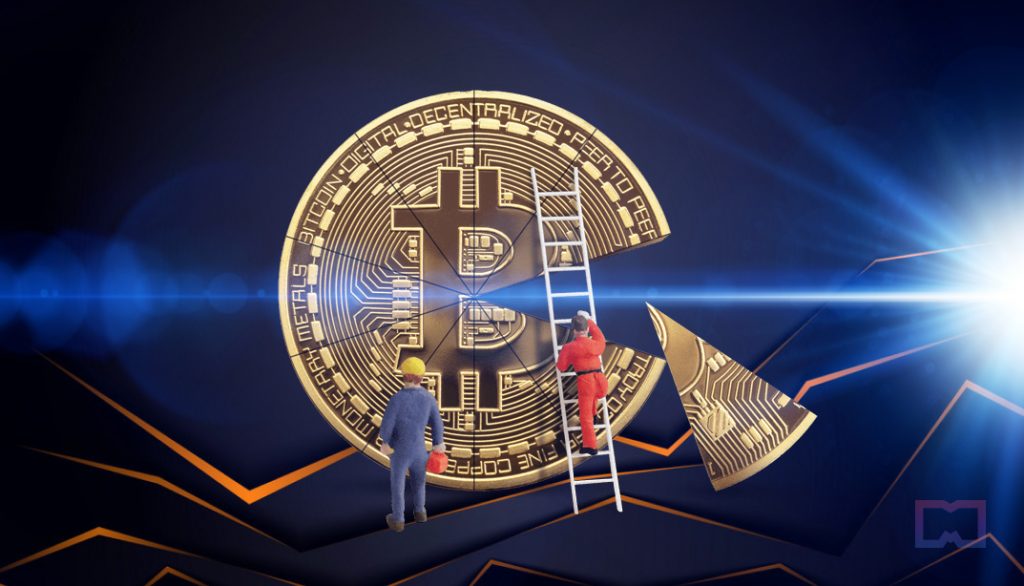Bitcoin halving: The ultimate guide (2023)
In Brief
Bitcoin halving reduces the amount of new BTC that enters circulation and significantly impacts the price.
Bitcoin halving is a planned event every four years where the block rewards miners for each block.
Introduction
The Bitcoin halving is an event that happens every four years. On this day, the block reward for miners is cut in half, reducing the amount of new BTC that enters circulation. This event significantly impacts the price of Bitcoin, and it’s important to understand why it happens and how it works. In this guide, we’ll explain what you need to know about Bitcoin halving and why it’s important for the future of this cryptocurrency.

The best way to stay on top of the Bitcoin halving event is to simply keep track of its official website. This page will provide you with all the necessary information, such as the current countdown and block number. It is a good idea to bookmark this page or save it somewhere handy where you can access it whenever you need to. By doing this, you’ll always be one step ahead of everyone else when it comes to the Bitcoin halving event.
Of course, many people are also interested in learning more about the history of Bitcoin and the role that halving has played in its development. Here are a few facts and figures to help you better understand this important event:
– The first Bitcoin halving occurred at block 210,000 on November 28, 2012. At that time, the block reward was reduced from 50 BTC to 25 BTC.
– The next Bitcoin halving is anticipated to occur at block 630,000, which will be in May of 2024. Experts believe that this halving event could drive the price of Bitcoin even higher than it already is.
– Some analysts have predicted that there will only be 21 million Bitcoins in circulation by the time the next halving occurs. This would mean that each Bitcoin would be worth a significant amount of money, as demand for this cryptocurrency continues to rise.
– While no one knows for sure how the Bitcoin halving event will affect its price and overall popularity, it is certainly an important development to keep an eye on. Whether you are a Bitcoin investor or just someone who is interested in this cryptocurrency, it’s important to stay informed about the latest developments related to Bitcoin halving. By doing so, you can make more informed decisions when it comes to your own investments and future plans involving Bitcoin.

Whether you are an avid investor in Bitcoin or just someone who is interested in cryptocurrency, it’s important to keep an eye on the upcoming Bitcoin halving. By staying informed about this event and following all of the latest news and developments related to it, you can make better investment decisions and prepare yourself for whatever may come next. After all, history has shown that Bitcoin halving is an important event that can have a significant impact on the future of this cryptocurrency.
What is Bitcoin halving?
The Bitcoin halving, also simply known as “halving,” is a planned event every four years where the block reward for miners is cut in half. This reduces the amount of new BTC that enters circulation and significantly impacts the price.
The Bitcoin halving is a scheduled event that happens every 210,000 blocks. When a new block is mined, the miners are rewarded with a certain number of bitcoins. However, the number of bitcoins rewarded for each block decreases with each subsequent block. This halving process continues until all 21 million bitcoins have been mined.
The halving aims to keep inflation in check and control the issuance of new bitcoins. By decreasing the number of new bitcoins that enter circulation, the Bitcoin network can avoid inflation and ensure that there is not too much dilution of the value of each bitcoin.
Basics of the Bitcoin Network
Bitcoin is a decentralized network that allows users to transact with each other without the need for a third party, such as a bank or financial institution. Transactions are verified by a process called “mining,” in which computers solve complex mathematical problems to add transaction data to the Bitcoin public ledger, called the blockchain.
The number of bitcoins mined per block halves every 210,000 blocks or approximately every four years. This event is known as the “halving.” The halving reduces the rewards that miners receive for verifying transactions. As a result, it also reduces the rate at which new bitcoins are created. The most recent halving occurred in May 2020.
The halving is a crucial part of Bitcoin’s design and is one of the main reasons the cryptocurrency has succeeded. By reducing the supply of new bitcoins, the halving increases scarcity and should help drive the price.
Investors often view the halving as bullish because it reduces supply and could lead to higher prices. However, it’s important to note that the halving is a long-term event, and its effects may not be immediately apparent. Data from the past three halvings suggests price performance in the months leading up to the event has been mixed.
The first halving occurred in November 2012 when the block reward was cut from 50 BTC to 25 BTC. The second halving took place in July 2016 and reduced the block reward to 12.5 BTC.
In both cases, prices rallied in the months leading up to the event but then pulled back in the immediate aftermath. Investors were anticipating the halving and sold when it finally occurred.
It’s also worth noting that the 2012 and 2016 halvings occurred during broad-based bullishness in the cryptocurrency market. The third halving reduced the block reward to 6.25BTC on May 11, 2020. Halving occurred during uncertainty, leading to a different price reaction. Investors should carefully consider these factors before deciding about investing in Bitcoin.

Basics of Bitcoin mining
Bitcoin mining is the process of releasing bitcoins. Miners are rewarded with bitcoin for verifying and committing transactions to the distributed ledger blockchain. Mining is an essential part of Bitcoin that helps to ensure fairness while keeping the network stable, safe, and secure.
The process of creating new bitcoins is called “mining.” Miners are rewarded with bitcoins for verifying and committing transactions to the blockchain. Mining is an essential and integral part of bitcoin that ensures fairness while keeping the bitcoin network stable, safe, and secure.
To mine bitcoins, miners need to solve complex mathematical problems. The difficulty of this problem varies over time, and as more miners join the network, the difficulty increases, making it harder to mine bitcoins.
The purpose of bitcoin mining is to ensure that all users have a consistent view of the blockchain. By verifying and committing transactions to the blockchain, miners help to keep the network secure and ensure that all users have a consistent view of the blockchain. As of 2022, the current halving reward for mining a block is 6.25 bitcoins.
When did the Bitcoin halvings happen?
The first ever Bitcoin halving occurred on November 28, 2012. The reward for each block mined was cut in half from 50 BTC to 25 BTC. Bitcoin’s second halving occurred on July 9, 2016. Again, the reward for each block mined was cut in half, from 25 BTC to 12.5 BTC.
The most recent halving took place on May 11, 2020. On that date, one bitcoin is priced at $8,821. On April 14, 2021, a single Bitcoin soared in value to $63,233—an 617% increase from its price before halving occurred. A month later, on May 11, the value had decreased slightly to $49,504, but this still represented an increase of 461%, which is more in line with values seen after the 2016 event.
What changes with Bitcoin halving?
The significant change that happens during a Bitcoin halving is the reduction in the block reward. As mentioned, before the most recent halving, miners were rewarded 12.5 BTC for each block they mined. Following the event, they only received 6.25 BTC per block. This may not seem a big deal, but it significantly impacts the Bitcoin network.
To start with, it reduces the supply of new BTC entering the market. Since there are now fewer BTC being mined, fewer are available for purchase. This could affect the price of Bitcoin, as demand may begin to outstrip supply. Of course, it’s impossible to say how the market will react, but it is something to keep in mind.
In addition, the halving also has an impact on the mining industry itself. With the block reward cut in half, miners must find other ways to compensate for the lost revenue. This could mean that some miners will be forced to shut down their operations, as they will no longer be profitable. This could lead to a decrease in the hashrate, the total amount of computing power used to mine Bitcoin.
While all of this may sound doom and gloom, it’s important to remember that halving is good for Bitcoin. It’s one of the critical mechanisms that help to keep inflation in check and ensures that the BTC supply doesn’t get out of control. So, even though there may be some short-term pain for miners and the market, in the long run, the halving is a positive event for Bitcoin.
What effects does a Bitcoin halving have?
When the halving happens, a few things are affected. The first is the block reward, which is cut in half. This affects the miners, as their revenue stream is reduced by half. This could lead to some miners quitting the network, as mining may no longer be profitable, thus decreasing the hashrate, which would make the network less secure.
Another effect of the halving is that it reduces the supply of new BTC entering the market. This could impact the price, as demand may exceed supply. The halving is priced in, so there may be no effect on the price.
Finally, the halving could impact the psychology of investors and traders. For some, it could be seen as a positive event, as it reduces the supply of new BTC and could lead to an increase in price. For others, it could be seen as an adverse event, as it reduces the miners’ revenue stream and could decrease the hashrate. Only time will tell how the halving will affect the market.
Pros and cons of Bitcoin halving
Bitcoin halving is an event that happens every four years and reduces the rewards given to miners by 50%. This event is significant because it affects the supply and demand of Bitcoin and its price. Some believe halving events are positive for Bitcoin, while others think they will negatively impact it.
Pros:
- Increased demand: When the rewards given to miners are reduced, there will be less Bitcoin in circulation. This usually leads to increased demand and price as people try to buy Bitcoin before it becomes too rare.
- More stable prices: The reduced supply can help to stabilize prices, making Bitcoin a more attractive investment.
- Improved security: With less Bitcoin in circulation, it becomes more difficult for attackers to 51% attack the network. This makes Bitcoin more secure and resistant to attacks.
Cons:
- Less incentive for miners: The reduced rewards given to miners can make it less profitable to mine Bitcoin, leading to a decrease in hashrate. This could make Bitcoin less secure as there would be fewer miners to process transactions and secure the network.
- Increased centralization: If the mining rewards are reduced, it could lead to centralization since only those with large amounts of money would afford expensive mining equipment. This could make Bitcoin less decentralized and more vulnerable to attacks.
Only time will tell how the upcoming halving event will impact Bitcoin. However, it is vital to be aware of the potential pros and cons of making an informed decision about whether or not to invest in Bitcoin.
FAQs
Bitcoin halving is the process that sees the block reward for mining new blocks reduced by 50%. This happens every 210,000 blocks or roughly every four years.
The main reason for Bitcoin halving is to control the supply of new Bitcoins. Reducing the block reward makes it more expensive for miners to generate new Bitcoins, which should help keep inflation in check.
Your mining rewards will have the most immediate impact if you own Bitcoin. If you are a miner, your reward is cut in half. However, it is essential to remember that the halving also has the potential to reduce transaction fees and increase the value of Bitcoin.
Some believe Bitcoin’s halving could lead to a “mining death spiral.” Miners are forced to sell their coins at a loss to cover the mining costs. However, it is essential to remember that the halving also has the potential to reduce transaction fees and increase the value of Bitcoin.
The next Bitcoin halving is scheduled for May 9, 2024. However, the date could change if the block reward is increased or decreased.
Conclusions
As we have seen, the halving of Bitcoin is a significant event that happens every four years and significantly impacts the cryptocurrency. It is designed to control the supply of BTC and ensure that it remains scarce, which in turn should maintain its value. While the long-term effects of halving are still unknown, it is a significant event in the history of Bitcoin.
So, what does the future hold for Bitcoin after the halving? Only time will tell, but one thing is for sure – the halving is an event that every Bitcoin holder should keep an eye on.
Related articles
- Bitcoin payments: How to accept them in your store
- Is Bitcoin legal? A look at BTC’s regulatory environment
- Bitcoin market: BTC has been in a very tight price range for nearly the past year
Disclaimer
In line with the Trust Project guidelines, please note that the information provided on this page is not intended to be and should not be interpreted as legal, tax, investment, financial, or any other form of advice. It is important to only invest what you can afford to lose and to seek independent financial advice if you have any doubts. For further information, we suggest referring to the terms and conditions as well as the help and support pages provided by the issuer or advertiser. MetaversePost is committed to accurate, unbiased reporting, but market conditions are subject to change without notice.
About The Author
Moses is an experienced freelance writer and analyst with a keen interest in how technology is disrupting the financial sector. He has written extensively on the subject of cryptocurrencies from an investment perspective, as well as from a technical standpoint. He has also been involved in trading cryptocurrencies for over two years.
More articlesMoses is an experienced freelance writer and analyst with a keen interest in how technology is disrupting the financial sector. He has written extensively on the subject of cryptocurrencies from an investment perspective, as well as from a technical standpoint. He has also been involved in trading cryptocurrencies for over two years.


















































